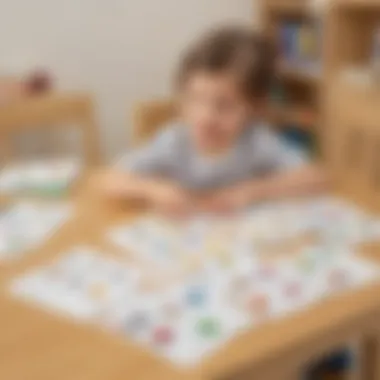Unlocking Literacy: A Comprehensive Guide to Teaching Phonics


Creative Activities
When embarking on the journey of teaching phonics to elementary school children, incorporating creative activities can significantly enhance the learning process. By engaging in hands-on craft ideas, children can not only have fun but also reinforce their understanding of phonetic concepts. These craft activities should be easily replicable, promoting independent exploration and learning. Detailed step-by-step guides accompanying each activity can provide clear instructions for children to follow, enhancing their fine motor skills and cognitive development. Moreover, discussing the educational value of these activities can shed light on how they contribute to building a strong foundation in literacy skills.
Fun Quizzes
Integrating fun quizzes into phonics instruction can make the learning experience more interactive and engaging for young learners. Covering a range of topics relevant to phonics, these quizzes aim to test children's knowledge and reinforce their understanding of key concepts. By incorporating various question types, such as multiple choice, fill-in-the-blank, and matching, these quizzes cater to different learning styles and abilities. Through consistent participation in these quizzes available on Elem Fun, children can reinforce their phonics knowledge and boost their retention of information, leading to improved literacy skills.
Fact-Based Articles
In addition to hands-on activities and interactive quizzes, providing access to fact-based articles can broaden children's exposure to diverse topics related to phonics. These articles are designed to present information in an engaging and easy-to-understand manner, catering to the cognitive level of elementary school students. Covering a wide range of topics within the realm of phonics, these articles not only expand children's knowledge but also encourage them to explore different aspects of language and literacy. Additionally, incorporating links to additional resources in the articles can encourage further exploration and independent learning, fostering a deep understanding of phonics concepts.
Introduction
Importance of Phonics Instruction
Phonics instruction plays a pivotal role in fostering reading proficiency among young learners. By decoding the relationship between letters and sounds, phonics equips children with essential skills needed for fluent reading. The emphasis on phonics in early education serves as a cornerstone in building strong literacy foundations.
The role of phonics in reading development
The role of phonics in reading development lies in its ability to equip students with the necessary tools to navigate written language effectively. Understanding phonics enables children to decipher words accurately, paving the way for improved comprehension and fluency.
Benefits of teaching phonics in early education
Teaching phonics in early education environments offers children a structured approach to learning letter-sound correspondences. This methodical progression not only enhances reading skills but also cultivates strong spelling abilities, laying a robust foundation for academic success.
Understanding Phonics
Phonics, at its core, involves the association between sounds and corresponding letters, facilitating language decoding and reading proficiency. This section delves into defining phonics and elucidates how this technique enriches both reading and spelling capabilities.
Definition of phonics
Phonics is the instructional method that emphasizes the connection between sounds and written symbols. By teaching phonics, educators enable students to decode words accurately and independently, thus enhancing their overall literacy skills.
How phonics enhances reading and spelling
The integration of phonics instruction into curriculum enhances students' reading and spelling abilities by providing them with systematic strategies to decipher unfamiliar words. This phonemic awareness contributes significantly to literacy development, fostering confidence in young readers.
Setting the Foundation
Establishing a strong foundation in phonics begins with introducing essential components such as alphabet sounds and letter recognition. These fundamental building blocks set the stage for more advanced phonics concepts.
Introducing the alphabet sounds


Introducing students to alphabet sounds involves familiarizing them with the distinct vocalizations each letter represents. By mastering these sounds, children can efficiently decode words and enhance their overall reading fluency.
Teaching letter recognition
Teaching letter recognition encompasses helping students identify and differentiate between letters. This skill is critical in developing a child's ability to spell and read words accurately, laying the groundwork for advanced phonics proficiency.
Building Blocks of Phonics
c When it comes to the foundations of learning, the Building Blocks of Phonics play a critical role in children's literacy development. By focusing on key elements such as understanding short vowel sounds, introducing consonant blends, and mastering digraphs, this section provides a solid framework for advancing phonics skills. One of the primary benefits of delving into these building blocks is the enhancement of reading and spelling abilities, setting a strong foundation for future language proficiency.
Learning Short Vowel Sounds
Explanation of Short Vowel Sounds
In the realm of phonics instruction, grasping the concept of short vowel sounds stands as a pivotal element. Short vowel sounds are fundamental in recognizing and pronouncing words accurately, contributing significantly to overall reading fluency. By emphasizing the unique characteristics of short vowel sounds and reinforcing their importance through targeted activities, children can enhance their phonemic awareness and decoding skills effectively. This emphasis on short vowel sounds in the learning process serves as a popular approach due to its proven effectiveness in building core literacy skills.
Activities to Reinforce Short Vowel Sounds
To consolidate understanding and mastery of short vowel sounds, engaging in activities that reinforce these sounds is crucial. Incorporating interactive exercises and games that focus on short vowel discrimination and phonemic segmentation can aid in solidifying children’s grasp of these essential phonetic elements. This active engagement not only makes learning enjoyable but also enhances retention and application of short vowel sound knowledge. While these activities offer numerous advantages in reinforcing phonics skills, ensuring a balanced mix of instructional approaches is important to cater to diverse learning styles.
Introducing Consonant Blends
What are Consonant Blends?
Within the landscape of phonics, consonant blends represent a significant component that contributes to children’s ability to decode and recognize words fluently. Consonant blends are combinations of two or more consonant sounds occurring together in a word, such as in 'fl,' 'br,' or 'cl.' Understanding and practicing consonant blends are crucial in developing strong phonemic awareness and spelling skills. The focus on consonant blends in this article serves as a strategic choice due to its vital role in expanding vocabulary and improving reading proficiency.
Practicing Consonant Blends Through Games
Enhancing children's proficiency in consonant blends can be creatively achieved through game-based learning. Games targeting consonant blends not only make the learning process interactive and enjoyable but also provide a context for practical application of phonics knowledge. By incorporating playful exercises that require identifying and using consonant blends in words, students can internalize these phonetic elements effectively. Leveraging games to practice consonant blends offers a dynamic approach to phonics education, promoting active participation and skill development among learners.
Mastering Digraphs
Definition and Examples of Digraphs
Delving into the realm of advanced phonics, mastering digraphs becomes a crucial step in developing comprehensive reading and decoding abilities. Digraphs are combinations of two letters representing a single sound, such as 'ch,' 'sh,' or 'th.' Understanding the definition and examples of digraphs is essential for children to decode words accurately and efficiently, particularly when faced with more complex linguistic patterns. The inclusion of digraphs in phonics instruction aids in expanding vocabulary and enhancing reading comprehension.
Exercises to Help Children Recognize Digraphs
Facilitating children's recognition and application of digraphs can be effectively achieved through targeted exercises. By engaging in activities that require identifying, differentiating, and using digraphs in words, students can sharpen their phonetic analysis skills and reading proficiency. These exercises offer a structured approach to familiarizing children with the nuances of digraphs, enabling them to navigate and decipher words with confidence. The incorporation of exercises focusing on digraphs enriches the phonics curriculum, equipping learners with essential skills for decoding and understanding written text.
Moving to Intermediate Phonics
While mastering basic phonics skills lays a sturdy foundation for reading and spelling, advancing to intermediate phonics plays a crucial role in enhancing the literacy journey of elementary school children. Moving to intermediate phonics signifies a progression towards more complex phonetic patterns and rules, allowing students to tackle higher-level words with confidence. This section delves into long vowel sounds, r-controlled vowels, and silent letters, providing a comprehensive understanding of more intricate phonics concepts to expand children's reading capabilities.


Long Vowel Sounds
Exploring long vowel sound patterns
Exploring long vowel sound patterns is a pivotal aspect of intermediate phonics instruction. By delving deeper into the various patterns that long vowel sounds can exhibit, students gain a nuanced understanding of how vowels can function in words. This exploration aids in recognizing common phonetic patterns and empowers children to decode words more efficiently. An essential characteristic of exploring long vowel sound patterns is its emphasis on recognizing the different ways vowels can produce sounds, enabling learners to grasp the complexities of English phonetics.
Long vowel sound word activities
Engaging in long vowel sound word activities is a strategic method to reinforce understanding and application of long vowel sounds. These activities provide hands-on practice in identifying and utilizing long vowel sounds within words, promoting retention and fluency in reading. The key characteristic of long vowel sound word activities lies in their interactive nature, making learning enjoyable and effective. By incorporating these activities, educators can enhance students' phonetic awareness while fostering a deeper appreciation for the intricacies of vowel sounds.
Understanding R-Controlled Vowels
In-depth look at r-controlled vowel sounds
Taking an in-depth look at r-controlled vowel sounds is paramount in intermediate phonics education. This exploration delves into the unique nature of r-controlled vowels, where the letter 'r' influences the pronunciation of preceding vowels. By understanding these distinct vowel sound patterns, students can decipher words accurately and fluently. The key characteristic of this study lies in its ability to unveil the complexity of r-controlled vowels, guiding learners towards mastering this phonetic phenomenon.
Engaging exercises for r-controlled vowels
Engaging in exercises tailored to r-controlled vowels is a dynamic approach to solidify comprehension and application. These exercises are designed to challenge students to recognize, pronounce, and differentiate words containing r-controlled vowels. By actively participating in these engaging activities, children sharpen their phonetic skills and boost their confidence in tackling words with r-controlled vowel sounds. The uniqueness of these exercises lies in their hands-on nature, providing a stimulating environment for learners to practice and internalize r-controlled vowel concepts.
Teaching Silent Letters
Identifying and explaining silent letters
The identification and explanation of silent letters are integral components of intermediate phonics instruction. Students explore the presence of silent letters in words, understanding when certain letters remain silent during pronunciation. This knowledge empowers children to navigate silent letters strategically, enhancing their word recognition and spelling accuracy. The key characteristic of identifying and explaining silent letters is its role in demystifying spelling anomalies, equipping students with the tools to decode words proficiently.
Practical ways to teach silent letters
Employing practical strategies to teach silent letters is a tactile approach that reinforces learning and retention. By incorporating activities that highlight silent letters in context, educators create opportunities for students to apply their understanding in meaningful ways. The advantage of incorporating practical methods lies in their efficacy in making abstract phonics concepts tangible and accessible for learners. These methods ensure that students grasp the purpose and function of silent letters, paving the way for improved spelling and reading skills.
Advanced Phonics Mastery
In the realm of elementary education, the Advanced Phonics Mastery section stands as a pivotal component within the overarching theme of Teaching Phonics. Advanced Phonics Mastery serves as the culmination of the structured learning journey, wherein students transcend basic phonics principles to delve into a realm of complex linguistic patterns and word structures. This advanced stage fosters a profound understanding of prefixes, suffixes, and intricate syllable divisions, pivotal for enhancing reading comprehension and spelling accuracy among young learners. By incorporating Advanced Phonics Mastery into the pedagogical framework, educators provide a solid foundation for students to navigate the multifaceted intricacies of the English language with confidence and adeptness, promoting literacy excellence from an early age.
Introduction to prefixes and suffixes
Delving into the intricacies of prefixes and suffixes adds a layer of depth to students' phonics proficiency. Understanding the role of affixes such as 'pre-' and 'un-' enhances children's ability to decode and comprehend a wide array of vocabulary. The systematic introduction of prefixes and suffixes equips learners with the tools to decipher the meaning of complex words by identifying these crucial linguistic components. By immersing students in activities centered around affix identification and usage, educators facilitate a nuanced understanding of word construction, enriching their linguistic competence and expanding their vocabulary repertoire.
Activities for understanding word affixes
Activities tailored to deepen students' grasp of word affixes offer a practical and engaging approach to phonics instruction. By incorporating interactive exercises emphasizing the application of prefixes and suffixes in context, educators encourage active participation and critical thinking skills development. These activities not only reinforce comprehension of affix meanings but also cultivate creativity and analytical thinking in young learners. Through hands-on tasks such as word-building games and affix matching exercises, students hone their ability to manipulate language components effectively, fostering a deeper appreciation for the intricacies of word formation and expanding their language proficiency organically.
Explaining syllable division strategies


Syllable division strategies serve as a fundamental aspect of phonics instruction, facilitating students' decoding and pronunciation skills. Delving into the systematic breakdown of words into manageable syllables aids learners in deciphering complex vocabulary with precision and fluency. By elucidating syllable division rules through clear, concise explanations, educators empower students to tackle unfamiliar words confidently, enhancing their reading comprehension and overall linguistic dexterity. Employing visual aids and mnemonic devices further reinforces retention of syllable division concepts, laying a robust foundation for advanced phonics mastery and language acquisition.
Practice exercises on syllable division rules
Engaging students in practice exercises centered around syllable division rules offers a hands-on approach to consolidating phonics skills. By providing guided activities that challenge students to apply syllable division strategies in varied contexts, educators promote active learning and cognitive reinforcement. These exercises encourage students to employ critical thinking and problem-solving skills in real-time, fostering a dynamic learning environment that nurtures competence and confidence in phonics application. Through consistent practice and targeted feedback, students refine their syllable division abilities, paving the way for seamless integration of advanced phonics principles into their reading and spelling acumen.
Applying phonics skills in reading comprehension
The integration of phonics skills in reading comprehension represents a critical juncture in students' literacy development. By bridging phonics instruction with comprehension exercises, educators foster a holistic approach to language acquisition that emphasizes both decoding and understanding. Applying phonics skills in reading equips students with the tools to decipher and analyze text effectively, promoting enhanced comprehension and retention of information. Through guided practice in reading fluency and text analysis, students not only refine their phonetic abilities but also cultivate a deeper appreciation for literature and language nuances, enriching their reading experience and academic proficiency.
Guided reading activities for fluency
Guided reading activities tailored to enhance fluency serve as a cornerstone in advancing students' phonetic proficiency. By guiding students through carefully curated reading material, educators provide scaffolded support that bolsters reading accuracy, speed, and comprehension. These activities aim to develop students' oral reading skills, enabling them to navigate text smoothly and expressively. Furthermore, guided reading cultivates metacognitive awareness in students, prompting them to reflect on their reading strategies and make connections between phonics principles and text comprehension. Through consistent engagement in guided reading exercises, students develop a heightened sense of fluency and textual analysis, nurturing a profound love for reading and language exploration.
Assessment and Progress Tracking
Assessment and progress tracking play a crucial role in ensuring the effectiveness of phonics instruction. Through regular assessments, educators can gauge students' understanding and tailor instruction to address individual needs. Tracking progress not only allows for the identification of areas needing improvement but also serves as a motivator for students to see their growth over time. By monitoring progress, teachers can adjust their teaching methods and strategies, leading to enhanced learning outcomes. Additionally, progress tracking provides valuable data for parents and caregivers to understand their child's development in phonics.
Implementing Phonics Assessments
Types of Phonics Assessments
Types of phonics assessments are essential tools for evaluating students' grasp of phonics concepts. These assessments may include segmenting and blending activities, reading fluency tests, and word recognition tasks. By utilizing various assessment techniques, educators can gain a holistic view of a child's phonics proficiency. Types of assessments contribute significantly to pinpointing specific areas where students may require additional support, enabling targeted interventions for improved learning outcomes. Types of phonics assessments stand out for their ability to provide detailed insights into a student's phonics skills. Their versatility makes them a popular choice for educators looking to assess various aspects of phonics knowledge comprehensively. Despite their advantages, these assessments may require proper administration and interpretation to yield accurate results. Educators must consider the unique features of each assessment type to ensure their effectiveness in evaluating students' phonics abilities.
Monitoring Student Progress Effectively
Monitoring student progress effectively is a key component of successful phonics instruction. It allows educators to track individual growth, identify areas for improvement, and measure the impact of teaching strategies. Effective progress monitoring involves using a combination of informal observations, formative assessments, and standardized tests. By carefully analyzing student data, teachers can make data-driven decisions to optimize instructional practices. Monitoring student progress effectively stands out for its real-time feedback on student performance. This feature is particularly beneficial as it enables prompt adjustments to teaching methods based on students' immediate needs. While effective progress monitoring is crucial for student success, educators must ensure that assessments are conducted consistently and fairly. Balancing the advantages of progress monitoring with its potential limitations is essential to maximizing its benefits in the context of phonics instruction.
Celebrating Milestones
Recognizing Student Achievements in Phonics
Recognizing student achievements in phonics is an essential component of fostering a positive learning environment. By acknowledging and celebrating students' progress, educators reinforce their efforts and boost their confidence. Recognizing achievements also encourages a growth mindset and motivates students to continue working diligently towards improving their phonics skills. Recognizing student achievements in phonics is distinguished by its impact on students' self-esteem and perseverance. This approach is a popular choice among educators for its ability to cultivate a supportive and encouraging atmosphere in the classroom. While celebrating milestones is highly advantageous, educators should be mindful of potential drawbacks, such as fostering a competitive mindset among students. By emphasizing collaborative learning and individual progress, recognizing student achievements can contribute significantly to a positive learning experience.
Incentives for Continued Growth
Incentives for continued growth serve as powerful motivators for students to engage in phonics learning actively. By offering rewards for achieving milestones or mastering new phonics skills, educators create a sense of accomplishment and drive among students. Incentives can take various forms, such as certificates, small prizes, or recognition in front of peers, to incentivize sustained effort and dedication to phonics. Incentives for continued growth are known for their ability to increase student motivation and involvement in phonics activities. This strategy is widely preferred by educators for its positive impact on students' enthusiasm for learning. However, incentives also pose challenges, such as the risk of externalizing motivation and overshadowing the intrinsic value of learning. Balancing the use of incentives with cultivating a genuine love for phonics remains essential in promoting sustained growth and development among students.
Conclusion
Teaching phonics is the cornerstone of literacy development in elementary school children. As the final chapter in this comprehensive guide, the importance of the conclusion cannot be overstated. It serves as the culmination of all the foundational knowledge provided throughout this article, tying together the key concepts discussed in preceding sections. The conclusion not only reinforces the significance of phonics instruction but also underlines its pivotal role in shaping children's reading and spelling abilities. By reiterating the proven benefits of a structured phonics approach, the conclusion empowers educators and parents to implement effective strategies for enhancing students' literacy skills. Emphasizing the value of phonics in fostering academic success and a lifelong love for reading, this section encapsulates the essence of the step-by-step guide.
Creating Phonics-rich Environments
Tips for Promoting Phonics Skills Outside the Classroom
Building a phonics-rich environment beyond the classroom is an indispensable aspect of holistic literacy education. By immersing children in phonics beyond school hours, parents and caregivers play a crucial role in reinforcing classroom learning and nurturing a deep understanding of phonics concepts. The key characteristic of promoting phonics skills outside the classroom lies in creating opportunities for practical application, such as encouraging reading aloud, word games, and word recognition activities in real-world contexts. This approach not only enhances retention but also instills a sense of relevance and applicability to phonics skills. The unique feature of promoting phonics at home is its flexibility and personalized nature, allowing tailored experiences that cater to individual learning styles and interests. While the advantages of promoting phonics skills outside the classroom are vast, including improved reading fluency, expanded vocabulary, and heightened confidence in language skills, it is essential to maintain a balance to prevent overwhelming young learners with excessive academic pressure.
Fostering a Love for Reading Through Phonics
Fostering a love for reading through phonics goes beyond imparting technical skills; it cultivates a lifelong passion for literature and learning. A key characteristic of this approach is the seamless integration of phonics activities with engaging storytelling, interactive reading sessions, and exposure to diverse genres and authors, creating an immersive reading experience that transcends mere decoding of words. This method not only enhances reading comprehension but also nurtures a deep appreciation for language, sparking curiosity and creativity in young readers. The unique feature of fostering a love for reading through phonics lies in its transformational impact on children's attitudes towards literacy, instilling a sense of joy and curiosity in exploring the vast world of books. While the benefits are manifold, including improved cognitive skills, critical thinking, and emotional intelligence, it is important to strike a balance between structured phonics instruction and fostering a genuine love for reading to ensure comprehensive literacy development.







